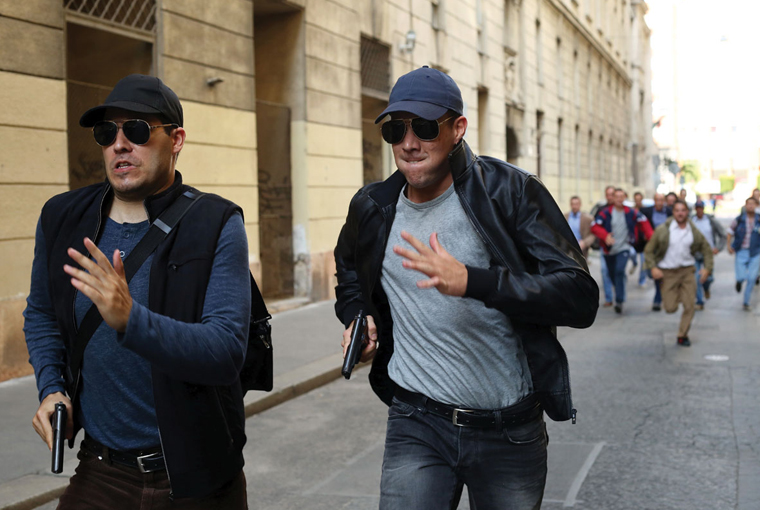(Post)socialist Folk Heroes
Nimród Antal’s The Whiskey Robber (A Viszkis 2017)
Vol. 81 (January 2018) by Anna Batori
Bank robberies, money, action, girls, and the Hungarian police. No wonder that the life of infamous whiskey robber Attila Ambrus would at some point be adapted for the movie screen. Eighteen years after the detention and five years after the release of this Hungarian Robin Hood, American-born film director Nimród Antal has finally summoned the courage to make a film about one of Hungary’s most heroic contemporary figures. Instead of a heist movie, Antal decided to focus on the moral background of the robber’s deeds, thus positioning the adventurous parts of his career in the background. This gives The Whiskey Robber a slow flow. While the film’s depressing Hungarian art house gait is disrupted by elements of the heist genre, the result is a monotonous and often shallow action-drama hybrid.
The weight on Antal’s shoulders to adapt the real story of Ambrus must have been unbearable. After all, Attila Ambrus is a modern folk hero who robbed more than twenty-six banks in the 1990s while playing a hilarious cat-and-mouse game with the police. Named after his habit to have a shot of whiskey before robbing a bank or post office, Ambrus slowly gained a star status in large parts of the society. Thousands of Hungarians admired him for outsmarting the police during his non-violent thefts. His knightly robberies made him a symbol of the transitional period: here is a man who fought the sudden capitalist transformation and ruthless bank sector. People wore T-shirts, mugs and baseball-hats that promulgated the success of the whiskey robber. Despite earning millions and living a luxurious life, in most people’s eyes, Ambrus remained the very archetype of the witty and underprivileged protagonist of fairy-tales. His real-life persona is complicated further by his Transylvanian origins. In short, the story of the whiskey robber seems to be too complex to be told in a single film.
Unfortunately, Antal tries the impossible and touches upon everything that marks the robber’s character, which, as a result, remains oddly untouched below the surface. He embarks on a journey to reveal all the anecdotes and circumstances – be they political, or moral – that led to the birth of the whiskey robber and transformed Attila Ambrus into a national hero. The narrative of the film is structured around three main time-lines that give the production a rather mosaic-like form, which harms both the character development and the story itself.
First, The Whiskey Robber introduces Ambrus’ (Bence Szalay) abusive childhood in Ceaușescu’s Transylvania, thus laying the psychological foundation for the moral narrative. Being a Hungarian in Socialist Romania is nothing but easy, but it gets even harder when, after losing his grandmother, Ambrus is sent to a reformatory and then to the army where he is constantly humiliated. As an outsider, Ambrus decides to escape to Hungary by riding underneath a Romanian freight train and eventually starts a new life in his mother country. Although he applies for Hungarian citizenship and political asylum, his hands are tied because of the deeply corrupt system that only hands out papers to those who are willing to pay for them. The lack of money and working permit are, according to the film, the most acceptable reasons why he decides to rob a post office; it is the drive to become a Hungarian with legal documents and finally have a sense of belonging that pushes Ambrus to commit a crime.
Unfortunately, without a detailed depiction of the corrupt political system of post-1989 Hungary and Ambrus’ tragic fate within it (which compelled him to work various humiliating jobs), such rationalizations remain rather shallow. Instead of concentrating on his first steps in his mother country and the feelings Ambrus might have had when arriving in Hungary, Antal focuses on his physical journey to Budapest and dwells on his ice-hockey career. The childhood time-line evaporates way too quickly and so do important emotional details that accompany his changing places. Antal tried his best to dig deep into the robber’s consciousness and moral background, but this took away important screen time from his protagonist’s first steps in Hungary. Although the director invites us to examine the incredibly difficult situation of Ambrus in the new Hungarian context – e.g. by depicting the dismissive attitude of his girlfriend’s wealthy parents –the real depth of the robber’s financial and psychological plight remains untouched. Due to the never-ending jumps between past and present, the moral background that Antal was so desperate to scrutinize falls short, giving the viewer no ground to identify with the film’s hero.
The second story-line that aims to support the narrative flow is Ambrus’s interrogation by a chief of police. Antal spares us none of the details that make up that process, thus anticipating the outcome of the story with self-incurred spoilers. Curiously, these trite interrogation scenes add nothing to the story. We would expect outrage, anger and wrath from the police for being fooled by Ambrus, but only get disappointment and jealousy. The officer takes pills during breaks and his character and motivations – thanks to the trifling screenplay – remain superficial and/or unknown.
The final and most interesting story-line portrays Ambrus’ bank robberies and his life between the crimes. Scenes from his unsuccessful ice hockey career are intercut with episodes from his relationship with Kata (Piroska Móga), which plays out against the background of a hectic and luxurious lifestyle set in casinos and expensive restaurants. Despite the excellent editing and brilliant action-scenes, the lack of deeper character-descriptions annihilates the story. The Whiskey Robber remains a film without real cohesive force, a movie that piles up action-scenes and dramatic plot points without bothering to explain them. To be fair, the impressive visual structure that connects time-lines without any evident graphic interruption turns Antal’s film into a great filmic pleasure. Still, because of the imperfections of the screenplay, the most important story of the post-2000 Hungarian cinematic era that could have evoked the vicissitudes of the transitional period while addressing ethnic issues and saluting the whiskey robber as a symbol of the economic and political post-Socialist transformation, remains a well-photographed but superficial production.




The film is highly entertaining. Perfect – no. Successful – yes.